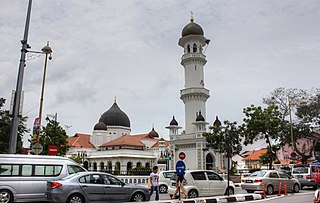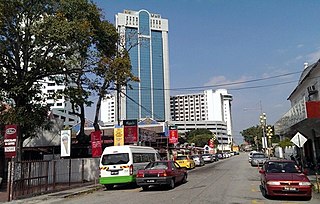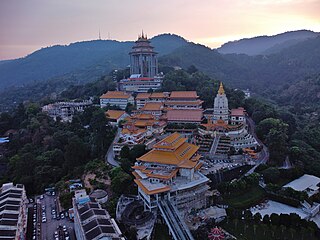
The Kek Lok Si Temple is a Buddhist temple within the city of George Town in the Malaysian state of Penang. Located at Ayer Itam, it is the largest Buddhist temple in Malaysia and an important pilgrimage centre for Buddhists from Hong Kong, the Philippines, Singapore and other parts of Southeast Asia. The entire complex of temples was built over a period from 1890 to 1930, an inspirational initiative of Beow Lean, the abbot. The main draw in the complex is the striking seven-storey Pagoda of the late Thai king Rama VI, which structure is known as the pagoda of Ten Thousand Buddhas with 10,000 alabaster and bronze statues of Buddha, and the 36.57-metre-tall (120 ft) bronze statue of Guanyin, the Goddess of Mercy. The 10.000 Buddhas concept belongs to the Chinese Mahāyāna school of Buddhism while Rama VI was king over a Theravāda country and Buddhist tradition.
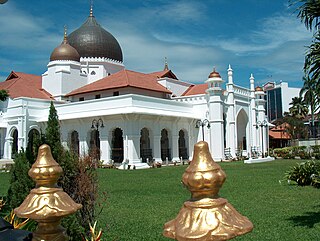
The Kapitan Keling Mosque is a mosque built in the 19th century by Indian Muslim traders in George Town, Penang, Malaysia. It is situated on the corner of Buckingham Street and Pitt Street. Being a prominent Islamic historic centre, it is part of the World Heritage Site of George Town and lies at the centre of the city's Tamil Muslim neighbourhood, the chulias. It is the first permanent Muslim institution to have been established in the area, dating from the early 1800s. Cauder Mohuddeen Merican is known as the founder of the mosque and leader of the Chulias. In 1801 Sir George Leith, who was then Lieutenant Governor of Penang, appointed a prominent Indian Muslim leader, Cauder Mohudeen, as Captain of the South Indian “Keling” community. He granted a piece of land to build a mosque on the south side of Malabar Street. Cauder Mohudeen was a ship mandoor or foreman from Porto Novo, which the Tamils called Paringgipettai and the Muslims Mahmudbandar, about 50 kilometres south of Pondicherry in India. He was referred to as 'Kapitan Kling'.

Green Lane is a major thoroughfare within the suburb of Batu Lanchang near George Town in Penang, Malaysia. Part of Penang Middle Ring Road, Green Lane starts from the intersection with Scotland Road and Air Itam Road, and stretches southwards to the Udini Roundabout within the Gelugor suburb.

The Goddess of Mercy Temple, also known as Kuan Im Teng or Kong Hock Keong, is a Mahayana Buddhist temple within George Town in the Malaysian state of Penang. Located at Pitt Street, it was built in 1728, making it the oldest Buddhist temple in the state.
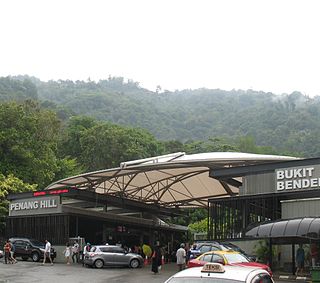
Hill Railway Station Road is a road in the city of George Town within the Malaysian state of Penang. Designated as Route P210, it stretches from the suburb of Air Itam to the Penang Hill Lower Railway Station at the foot of Penang Hill.

The Residency is the official residence of Penang's head of state, the governor of Penang. Located in the city of George Town in Penang, Malaysia, it was built by the British in 1888 and the mansion used to serve as the official residence of the highest-ranking British officer in Penang until Malayan independence in 1957.

Dhammikarama Burmese Temple is a Theravada Buddhist temple within George Town in the Malaysian state of Penang. Situated at Lorong Burma opposite Wat Chayamangkalaram, it is the only Burmese temple in the state, and a focal point for the annual Water, Thingyan and Mid-Autumn festivals in the city, as well as the Buddhist Lent.

St. George's Girls' School is an all-girls secondary school in George Town, Penang, Malaysia. Originally established in 1885, it is notable for its academic achievements and notable alumnae from different racial, ethnic and cultural backgrounds, leading to its inclusion in the Malaysian Ministry of Education's Cluster School and High Performance School systems. The school is academically selective, accepting only the top ten percentile of students from a number of primary schools, including Islands Girls' School, Northam Road Primary Girls' School, and Residency Road Girls' School. The teaching curriculum and environment is secular, making it popular with students from diverse racial, ethnic and/or religious affiliations. School facilities include well-equipped science laboratories, athletic field tracks, tennis courts, gymnasium for gymnastic training, and school canteen where students can buy inexpensive meals.

The Sun Yat-sen Museum Penang formerly called the Sun Yat-sen Penang Base, is a museum in George Town, Penang, Malaysia. The museum is dedicated to Sun Yat-sen, a Chinese nationalist who established the Republic of China after his efforts in the Xinhai Revolution.

Dhoby Ghaut is located within the city of George Town in the Malaysian state of Penang. It also known as Vannan Thora Tedal among the local Indian community.
N.K Menon (1895-1979) is Malaysian politician and medical doctor of Indian descent. He had serve as assemblyman for Jelutong in year 1954. He is well known for criticizing the exploitation of Indian labour by British capitalist. He also well known as the founder of Radical Party.
The Hindu Mahajana Sangam is an association of Indian workers. It is one of the Indian non-profitable organization at Penang, Malaysia which has been officially established in 1935 by waterfronts workers. Before 1935, it known as Kootakkadai .

GAMA is a department store in George Town, Penang, Malaysia. Located at Dato Keramat Road, just opposite Komtar, GAMA was opened in 1967, making it the oldest department store in the State of Penang. In spite of competition from the nearby shopping malls, the department store still retains its customer base due to its cheaper pricing. The shopping centre contains a total of eight floors, including its basement parking lot.

The Port of Penang is a deepwater seaport within the Malaysian state of Penang. It consists of terminals along the Penang Strait, including five in Seberang Perai and one in George Town. The Port of Penang was the third busiest harbour in Malaysia in terms of cargo as of 2017, handling 1.52 million TEUs of cargo, as well as the busiest port-of-call within the country for cruise shipping.

Ayer Rajah is a residential neighbourhood within the downtown core of George Town in the Malaysian state of Penang. This leafy, affluent neighbourhood, situated adjacent to the Penang Botanic Gardens, mostly consists of landed properties such as bungalows and semi-detached houses, surrounded by tree-lined avenues.

The Seri Teratai is the official residence of Penang's head of government, the Chief Minister of Penang. It is located in the city of George Town in Penang, Malaysia. The colonial-era double storey mansion was constructed in the early 20th century.
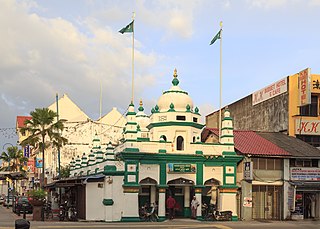
Nagore Durgha Sheriff is an early 19th century, Indian Muslim shrine situated at the junction of Chulia Street and King Street, George Town, Penang, Malaysia.












